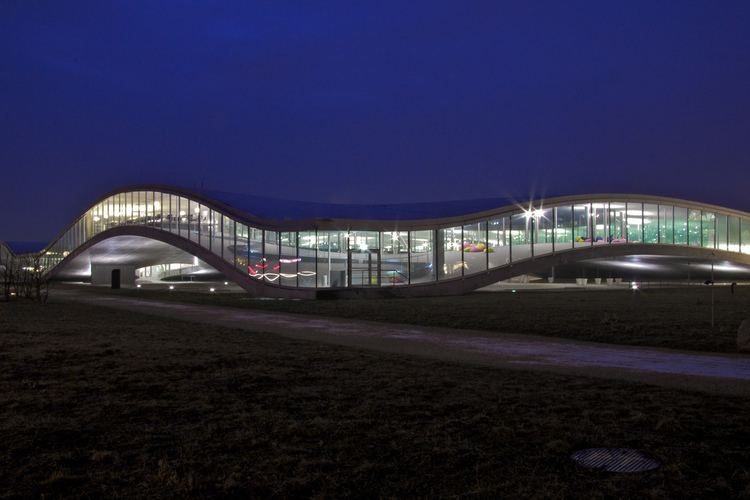Type of project Scientific Research Established 2013 (2013) | Location Europe | |
 | ||
Mission statement A collaborative effort to help understand the human brain | ||
The Human Brain Project (HBP) is a large ten-year scientific research project that aims to build a collaborative ICT-based scientific research infrastructure to allow researchers across the globe to advance knowledge in the fields of neuroscience, computing, and brain-related medicine. The Project, which started on 1 October 2013, is a European Commission Future and Emerging Technologies Flagship. The HBP is coordinated by the École Polytechnique Fédérale de Lausanne and is largely funded by the European Union. The project is based in Geneva, Switzerland.
Contents
Strategic goals
The Project develops ICT-based platforms in six areas:
The HBP Platforms consist of prototype hardware, software, databases, and programming interfaces. These tools are available to researchers worldwide via the HBP Collaboratory.
Organisation and funding
The HBP is coordinated by the École Polytechnique Fédérale de Lausanne, and scientific direction is provided by representatives from each of the HBP's Subprojects. The HBP involves researchers from over 100 institutions across Europe, and notable Partner Institutions include the University of Heidelberg, Forschungszentrum Jülich, and the University Hospital of Lausanne.
The call for funding for the Project's initial two-and-a-half-year 'Ramp-Up Phase' of EUR 54 million closed in November 2013 and the results were announced in March 2014. Twenty-two projects from thirty-two organisations were selected for the initial funding of EUR 8.3 million. The Ramp-Up Phase ended on 31 March 2016. Funding will be reassessed every two years using Specific Grant Agreements (SGA); the first of which is scheduled to begin in mid-2016. The HBP's total costs are estimated at EUR 1.019 billion, of which EUR 500 million would be provided by the European Commission, EUR 500 million by national, public and private organisations, and EUR 19 million by the Core Project Ramp-Up Phase Partners.
Obstacles
One of the Project's primary hurdles is the unsystematic nature of the information collected from previous brain research. Neurological research data varies by biological organisation schemes, species studied, and by developmental stages, making it difficult to collectively use the data to replicate the brain in a model that acts as a single system.
Other obstacles include engineering problems involving power consumption, memory, and storage. For example, detailed neuron representations are very computationally expensive, and whole brain simulation is at the leading edge of our computational capability.
Implications
Technologies generated by the HBP and other similar projects offer several possibilities to other fields of research. For instance, a brain model can be used to investigate signatures of disease in the brain and the impact of certain drugs, enabling the development of better diagnosis and treatment methods. Ultimately, these technologies will likely lead to more advanced medical options available to patients at a lower cost.
In addition, detailed brain simulation requires significant computing power, leading to developments in supercomputing and energy-efficient, brain-inspired computing techniques. Computational developments can be extended into areas such as data mining, telecommunications, appliances, and other industrial uses.
The long-term ethical consequences of the Project are also considered. The Project follows a policy of Responsible Research and Innovation, and its Ethics Advisory Board is responsible for monitoring the use of human volunteers, animal subjects, and the data collected. Implications on European society, industry, and economy are investigated by the HBP Ethics and Society Programme's Foresight Lab.
Criticism
An open letter was sent on 7 July 2014 to the European Commission by 154 European researchers (750 signatures as of 3 September 2014) complaining of the HBP's overly narrow approach, and threatening to boycott the Project. Central to this controversy was an internal dispute about funding for cognitive scientists who study high level brain functions, such as thought and behaviour. However, the HBP stated that there is “no question that cognition and behaviour are vital to the HBP”, explaining that cognitive neuroscience research was repositioned in the Project to allow the Core Project to focus on building the Platforms. In addition, The Open Letter called on the EC to “reallocate the funding currently allocated to the HBP core and partnering projects to broad neuroscience-directed funding to meet the original goals of the HBP—understanding brain function and its effect on society”. In its response, the HBP said that “while [neuroscience research] generates a vast amount of valuable data, there is currently no technology for sharing, organising, analysing or integrating this information, beyond papers and even databases. The HBP will provide the critical missing layer to move towards a multi-level reconstruction and simulation of the brain”. It added that “cognitive and behavioural neuroscience will become the most significant component of neuroscience in HBP over the course of the Project. However, for this to happen the Platforms have to be in place first”.
Peter Dayan, director of computational neuroscience at University College London, argued that the goal of a large-scale simulation of the brain is radically premature, and Geoffrey Hinton said that "[t]he real problem with that project is they have no clue how to get a large system like that to learn". Similar concerns as to the project's methodology were raised by Robert Epstein.
The HBP has said that its members share the uncertainty surrounding large-scale simulation, but that “reconstructing and simulating the human brain is a vision, a target; the benefits will come from the technology needed to get there. That technology, developed by the HBP, will benefit all of neuroscience as well as related fields”.
In 2015 the project went through serious management problems and was described as being in "disarray", with Markram losing his position in the executive leadership of the project.
